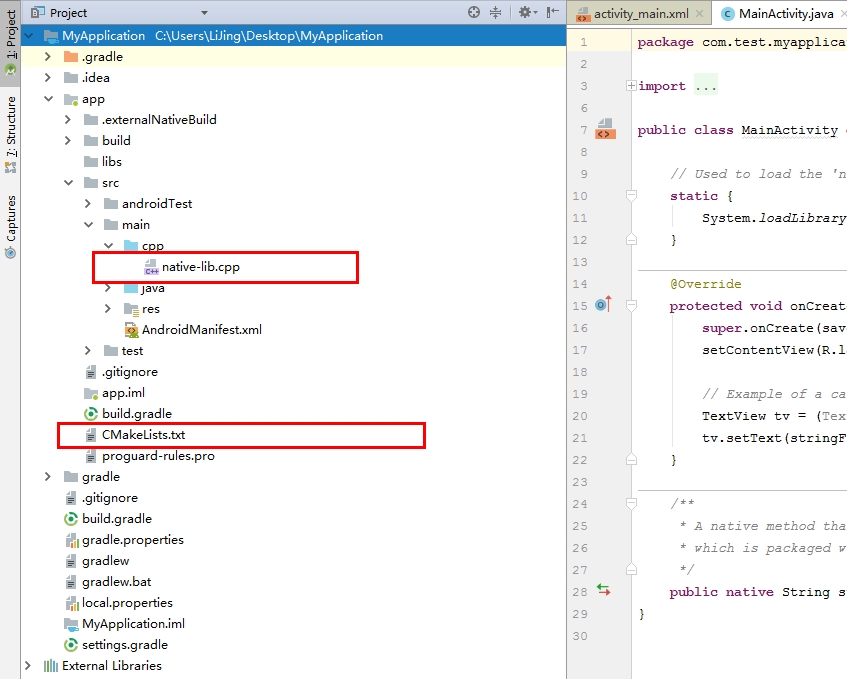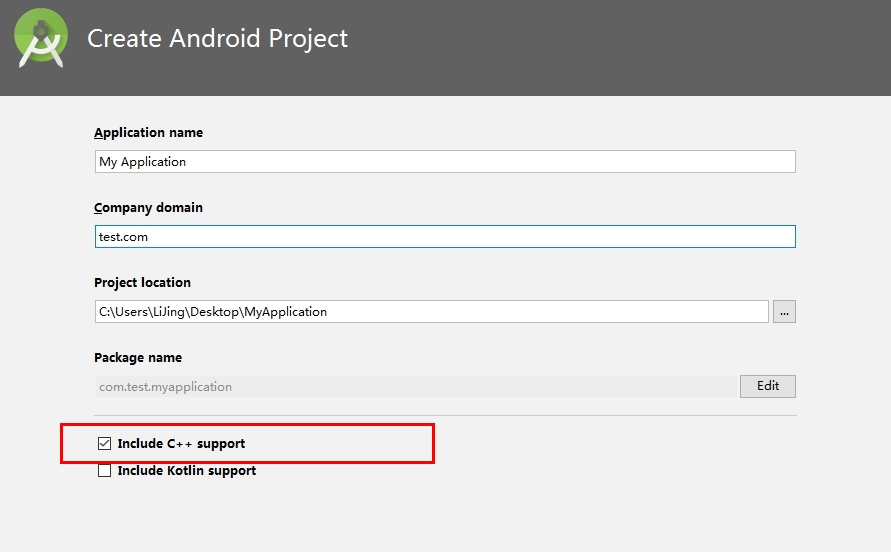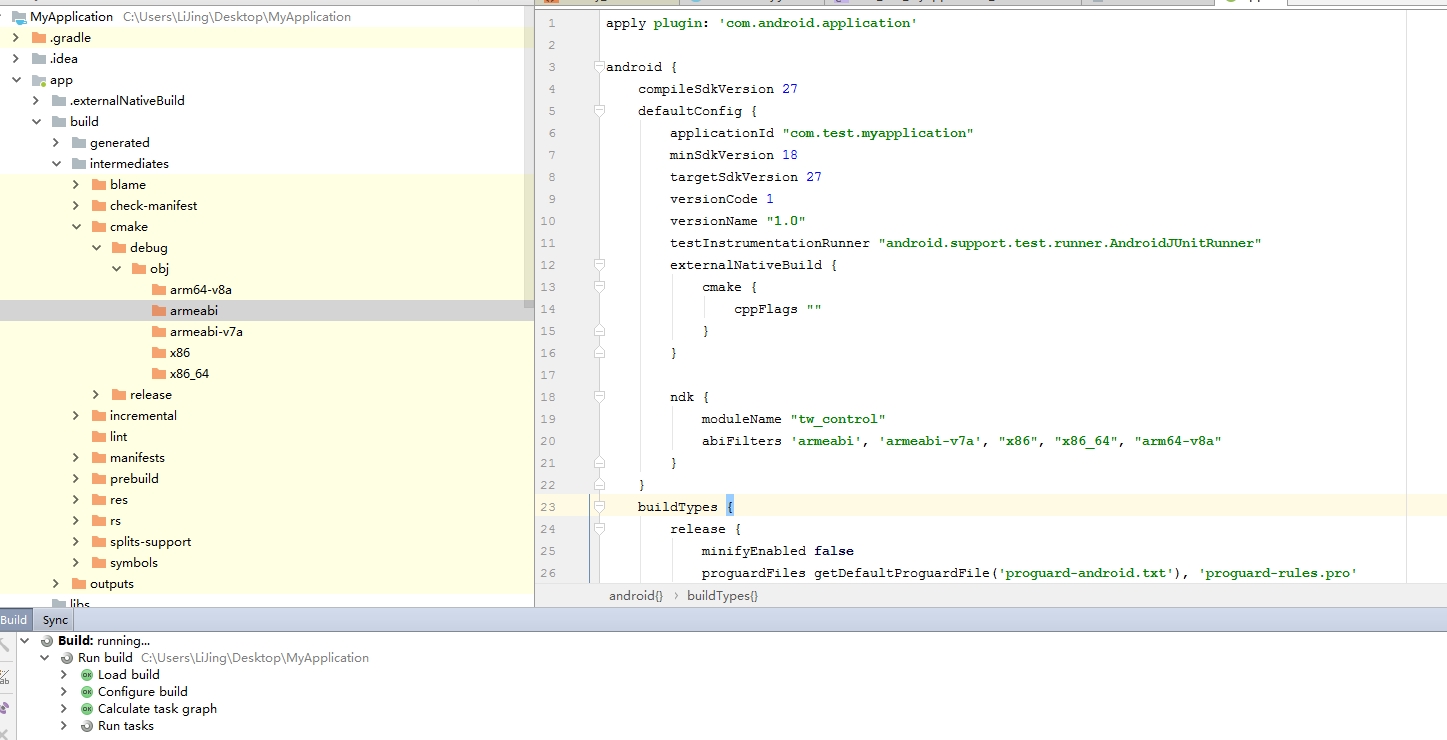Android 串列埠通訊自定義生成so檔案
串列埠通訊Android裝置通過串列埠與其他裝置進行通訊的一種方式,對於Android串列埠操作基本上就是對應串列埠檔案的讀寫,基本思路就是:
1.對串口檔案進行配置(波特率等),開啟串列埠檔案2.讀寫串列埠
3.關閉串列埠檔案
但是這裡需要注意的是Android中讀寫串列埠需要用到FileDescriptor類(檔案描述符)
關於串列埠通訊,Google已經給出了原始碼,具體地址如下:https://github.com/cepr/android-serialport-api,大家可以自行下載使用,直接使用時因為他已經將so已經打包生成好了,所以要保留Google原本的包名才行,如果不保留Google原本的包名
為了專案包名的一致性,不想用Google的包名,全部用自己的包名,這個時候就要自己生成so檔案了,下面講解怎麼自己生成so檔案。首先在Android Studio新建一個支援C/C++的專案
注意要勾選紅框中的內容,新建好的工程:會幫我們新建好兩個檔案,native-lib.cpp 和CMakeLists.txt

將下載的Google原始碼包中的SerialPort.java 類,新增到專案中
import android.util.Log; import java.io.File; import java.io.FileDescriptor; import java.io.FileInputStream; import java.io.FileOutputStream; import java.io.IOException; import java.io.InputStream; import java.io.OutputStream; public class SerialPort { private static final String TAG = "SerialPort"; /* * Do not remove or rename the field mFd: it is used by native method close(); */ private FileDescriptor mFd; private FileInputStream mFileInputStream; private FileOutputStream mFileOutputStream; public SerialPort(File device, int baudrate, int flags) throws SecurityException, IOException { /* Check access permission */ if (!device.canRead() || !device.canWrite()) { try { /* Missing read/write permission, trying to chmod the file */ Process su; su = Runtime.getRuntime().exec("/system/bin/su"); String cmd = "chmod 666 " + device.getAbsolutePath() + "\n" + "exit\n"; su.getOutputStream().write(cmd.getBytes()); if ((su.waitFor() != 0) || !device.canRead() || !device.canWrite()) { throw new SecurityException(); } } catch (Exception e) { e.printStackTrace(); throw new SecurityException(); } } mFd = open(device.getAbsolutePath(), baudrate, flags); if (mFd == null) { Log.e(TAG, "native open returns null"); throw new IOException(); } mFileInputStream = new FileInputStream(mFd); mFileOutputStream = new FileOutputStream(mFd); } // Getters and setters public InputStream getInputStream() { return mFileInputStream; } public OutputStream getOutputStream() { return mFileOutputStream; } // JNI private native static FileDescriptor open(String path, int baudrate, int flags); public native void close(); static { System.loadLibrary("twaer_control"); } }
修改最後一部分
static {
System.loadLibrary("twaer_control");
} "twaer_control"是自定義的要生成的so檔名,記住這個名,後面要用到
此時專案結構如下:
下面一步就是要生成 C語言標頭檔案
開啟 Terminal(View -> Tool Windows -> Terminal)
輸入cd app\src\main\java進入原始碼所在目錄
輸入javah com.test.myapplication.SerialPort生成標頭檔案
將前面生成的 .h 檔案移入cpp資料夾中,右鍵cpp選單中選擇New -> C/C++ Source File建立與 .h 檔案同名的 .c 檔案
將下載的Google原始碼包中的SerialPort.c 類拷貝到com_test_myapplication_SerialPort.c中
/*
* Copyright 2009-2011 Cedric Priscal
*
* Licensed under the Apache License, Version 2.0 (the "License");
* you may not use this file except in compliance with the License.
* You may obtain a copy of the License at
*
* http://www.apache.org/licenses/LICENSE-2.0
*
* Unless required by applicable law or agreed to in writing, software
* distributed under the License is distributed on an "AS IS" BASIS,
* WITHOUT WARRANTIES OR CONDITIONS OF ANY KIND, either express or implied.
* See the License for the specific language governing permissions and
* limitations under the License.
*/
#include <termios.h>
#include <unistd.h>
#include <sys/types.h>
#include <sys/stat.h>
#include <fcntl.h>
#include <string.h>
#include <jni.h>
#include "SerialPort.h"
#include "android/log.h"
static const char *TAG="serial_port";
#define LOGI(fmt, args...) __android_log_print(ANDROID_LOG_INFO, TAG, fmt, ##args)
#define LOGD(fmt, args...) __android_log_print(ANDROID_LOG_DEBUG, TAG, fmt, ##args)
#define LOGE(fmt, args...) __android_log_print(ANDROID_LOG_ERROR, TAG, fmt, ##args)
static speed_t getBaudrate(jint baudrate)
{
switch(baudrate) {
case 0: return B0;
case 50: return B50;
case 75: return B75;
case 110: return B110;
case 134: return B134;
case 150: return B150;
case 200: return B200;
case 300: return B300;
case 600: return B600;
case 1200: return B1200;
case 1800: return B1800;
case 2400: return B2400;
case 4800: return B4800;
case 9600: return B9600;
case 19200: return B19200;
case 38400: return B38400;
case 57600: return B57600;
case 115200: return B115200;
case 230400: return B230400;
case 460800: return B460800;
case 500000: return B500000;
case 576000: return B576000;
case 921600: return B921600;
case 1000000: return B1000000;
case 1152000: return B1152000;
case 1500000: return B1500000;
case 2000000: return B2000000;
case 2500000: return B2500000;
case 3000000: return B3000000;
case 3500000: return B3500000;
case 4000000: return B4000000;
default: return -1;
}
}
/*
* Class: android_serialport_SerialPort
* Method: open
* Signature: (Ljava/lang/String;II)Ljava/io/FileDescriptor;
*/
JNIEXPORT jobject JNICALL Java_android_1serialport_1api_SerialPort_open
(JNIEnv *env, jclass thiz, jstring path, jint baudrate, jint flags)
{
int fd;
speed_t speed;
jobject mFileDescriptor;
/* Check arguments */
{
speed = getBaudrate(baudrate);
if (speed == -1) {
/* TODO: throw an exception */
LOGE("Invalid baudrate");
return NULL;
}
}
/* Opening device */
{
jboolean iscopy;
const char *path_utf = (*env)->GetStringUTFChars(env, path, &iscopy);
LOGD("Opening serial port %s with flags 0x%x", path_utf, O_RDWR | flags);
fd = open(path_utf, O_RDWR | flags);
LOGD("open() fd = %d", fd);
(*env)->ReleaseStringUTFChars(env, path, path_utf);
if (fd == -1)
{
/* Throw an exception */
LOGE("Cannot open port");
/* TODO: throw an exception */
return NULL;
}
}
/* Configure device */
{
struct termios cfg;
LOGD("Configuring serial port");
if (tcgetattr(fd, &cfg))
{
LOGE("tcgetattr() failed");
close(fd);
/* TODO: throw an exception */
return NULL;
}
cfmakeraw(&cfg);
//設定波特率
cfsetispeed(&cfg, speed);
cfsetospeed(&cfg, speed);
if (tcsetattr(fd, TCSANOW, &cfg))
{
LOGE("tcsetattr() failed");
close(fd);
/* TODO: throw an exception */
return NULL;
}
}
/* Create a corresponding file descriptor */
{
jclass cFileDescriptor = (*env)->FindClass(env, "java/io/FileDescriptor");
jmethodID iFileDescriptor = (*env)->GetMethodID(env, cFileDescriptor, "<init>", "()V");
jfieldID descriptorID = (*env)->GetFieldID(env, cFileDescriptor, "descriptor", "I");
mFileDescriptor = (*env)->NewObject(env, cFileDescriptor, iFileDescriptor);
(*env)->SetIntField(env, mFileDescriptor, descriptorID, (jint)fd);
}
return mFileDescriptor;
}
/*
* Class: cedric_serial_SerialPort
* Method: close
* Signature: ()V
*/
JNIEXPORT void JNICALL Java_android_1serialport_1api_SerialPort_close
(JNIEnv *env, jobject thiz)
{
jclass SerialPortClass = (*env)->GetObjectClass(env, thiz);
jclass FileDescriptorClass = (*env)->FindClass(env, "java/io/FileDescriptor");
jfieldID mFdID = (*env)->GetFieldID(env, SerialPortClass, "mFd", "Ljava/io/FileDescriptor;");
jfieldID descriptorID = (*env)->GetFieldID(env, FileDescriptorClass, "descriptor", "I");
jobject mFd = (*env)->GetObjectField(env, thiz, mFdID);
jint descriptor = (*env)->GetIntField(env, mFd, descriptorID);
LOGD("close(fd = %d)", descriptor);
close(descriptor);
}
刪除紅色部分報錯的問題,點選右上角的Sync Now,成功之後下一步就要要配置NDK,生成so檔案,這裡用到的是CMakeLists.txt
主要就是講紅色框中的內容修改為我們上面的c檔名稱,其中1、3都是上面SerialPort.java中設定的生成so檔名,1和3兩個ya保持一致,2是上面的c檔案。接下來再看下build.gradle的配置改變:
apply plugin: 'com.android.application'
android {
compileSdkVersion 27
defaultConfig {
applicationId "com.test.myapplication"
minSdkVersion 18
targetSdkVersion 27
versionCode 1
versionName "1.0"
testInstrumentationRunner "android.support.test.runner.AndroidJUnitRunner"
externalNativeBuild {
cmake {
cppFlags ""
}
}
ndk {
abiFilters 'armeabi', 'armeabi-v7a', "x86", "x86_64", "arm64-v8a"
}
}
buildTypes {
release {
minifyEnabled false
proguardFiles getDefaultProguardFile('proguard-android.txt'), 'proguard-rules.pro'
}
}
externalNativeBuild {
cmake {
path "CMakeLists.txt"
}
}
}
dependencies {
implementation fileTree(dir: 'libs', include: ['*.jar'])
implementation 'com.android.support:appcompat-v7:27.1.1'
implementation 'com.android.support.constraint:constraint-layout:1.1.0'
testImplementation 'junit:junit:4.12'
androidTestImplementation 'com.android.support.test:runner:1.0.2'
androidTestImplementation 'com.android.support.test.espresso:espresso-core:3.0.2'
}1:defaultConfig中新增:
externalNativeBuild {
cmake {
cppFlags ""
}
} 2:在android{}中新增:
externalNativeBuild {
cmake {
path "CMakeLists.txt"
}
}3:配置so檔案生成平臺
ndk {
abiFilters 'armeabi', 'armeabi-v7a', "x86", "x86_64", "arm64-v8a"
}點選右上角的Sync Now,成功後我們可以在app\build\intermediates\cmake\debug\obj目錄下看到生成了我們之前設定的平臺目錄,但裡面還沒有so檔案。
到這裡就基本可以over了,最後我們點選Build--->Make Project,成功之後我們會在app\build\intermediates\cmake\debug\obj各個平臺目錄下看到已經生成了so檔案。













